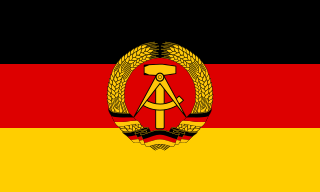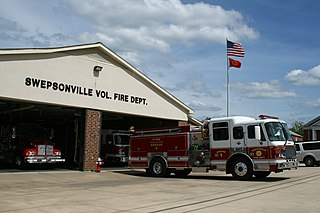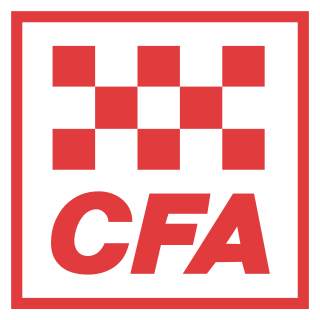
East Germany, officially the German Democratic Republic, was a state that existed from 1949 to 1990 in middle Germany as part of the Eastern Bloc in the Cold War. Commonly described as a communist state, it described itself as a socialist "workers' and peasants' state". Its territory was administered and occupied by Soviet forces following the end of World War II—the Soviet occupation zone of the Potsdam Agreement, bounded on the east by the Oder-Neisse line. The Soviet zone surrounded West Berlin but did not include it and West Berlin remained outside the jurisdiction of the GDR. Most scholars and academics describe the GDR as a dictatorship and as totalitarian.

A firefighter is a rescuer extensively trained in firefighting, primarily to extinguish hazardous fires that threaten life, property, and the environment as well as to rescue people and in some cases or jurisdictions also animals from dangerous situations. Male firefighters are sometimes referred to as firemen.

A fire department or fire brigade, also known as a fire authority, fire district, fire and rescue, or fire service in some areas, is an organization that provides fire prevention, fire suppression, rescue, and hazardous materials mitigation.

A volunteer fire department (VFD) is a fire department of volunteers who perform fire suppression and other related emergency services for a local jurisdiction. Volunteer and retained (on-call) firefighters are expected to be on call to respond to emergency calls for long periods of time, and are summoned to the fire station when their services are needed. They are also expected to attend other non-emergency duties as well.

Firefighting is the act of attempting to prevent the spread of and extinguish significant unwanted fires in buildings, vehicles, and woodlands. A firefighter suppresses fires to protect lives, property and the environment.
Fire police are volunteer fire brigade/company members who, based upon their jurisdictional authority, receive sworn police powers, special training, and support firefighting efforts at emergency incidents. In addition to securing firefighting equipment, incident and fire scenes, and the station itself, fire police perform traffic and crowd control. In some jurisdictions, fire police are exterior firefighters and may be called upon at fire scenes to perform any of the duties of an interior firefighter except those that require a self-contained breathing apparatus. On occasion, fire police also assist regular police: they perform road closures, traffic control, crowd control at public events, missing persons searches, parade details, salvage, security, and other miscellaneous tasks as requested.
In firefighting, the policy of two-in, two-out refers to United States Occupational Safety and Health Administration (OSHA) policy 29 CFR 1910.134(g)(4)(i) The respiratory protection standard requires that workers engaged in fighting interior structural fires work in a buddy system; at least two workers must enter the building together, so that they can monitor each other's whereabouts as well as the work environment. There must also be at least two standby personnel outside the fire area prepared to rescue the inside firefighters should the need arise. One of these outside firefighters must actively monitor the status of the inside fighters but the second outside firefighter may perform a variety of other duties, such as pump operations, incident commander or outside hose line operation. There are no provisions in the standard to waive the requirements for either the "two-inside firefighters" or the "two-outside firefighters", although the circumstances under which this provision applies are more limited than generally understood.

The Country Fire Authority (CFA) is a volunteer fire service responsible for fire suppression, rescues, and response to other accidents and hazards across most of the state Victoria, Australia. CFA comprises over 1,200 brigades organised in 21 districts, and shares responsibility for fire services with Fire Rescue Victoria, which employs full-time paid firefighters in major urban areas; and Forest Fire Management Victoria (FFMV), which manages fire prevention and suppression on Victoria's public lands. CFA operations and equipment are partly funded by the Victorian Government through its Fire Services Levy, and supplemented by individual brigades' fundraising for vehicles and equipment.

The London Fire Brigade (LFB) is the fire and rescue service for London, the capital of the United Kingdom. It was formed by the Metropolitan Fire Brigade Act 1865, under the leadership of superintendent Eyre Massey Shaw. It has 5,992 staff, including 5,096 operational firefighters and officers based at 102 fire stations.
Junior firefighting is a youth activity mostly organized by fire departments. It serves as a means of personal development for the youths, as well as a recruiting pool for the fire departments.

Fire fighting in Finland is regulated by the Ministry of the Interior. Municipalities of Finland can choose whether the fire and rescue services are provided by a professional fire brigade, a half-ordinary fire brigade or a voluntary fire brigade. Half-ordinary and voluntary fire brigades rely on non-professional voluntary fire fighters who have been trained appropriately. The main responsibilities of fire brigades are rescuing people, protecting property and the environment, limiting damage and consequences.

For centuries, firefighters have worn helmets to protect them from heat, cinders and falling objects. Although the shape of most fire helmets has changed little over the years, their composition has evolved from traditional leather to metals, to composite helmets constructed of lightweight polymers and other plastics.

Bunker gear is the personal protective equipment (PPE) used by firefighters. The term can refer, depending on the context, to just the trousers, boots and jacket, or to the entire combination of protective clothing. The terms are derived from the fact that the trousers and boots are traditionally kept by the firefighter's bunk at the fire station to be readily available for use.
As firefighting has a rich history throughout the world, traditions in this profession vary widely from country to country.

Essex County Fire and Rescue Service (ECFRS) is the statutory fire and rescue service for the county of Essex in the east of England, and is one of the largest fire services in the country, covering an area of 1,338 square miles (3,470 km2) and a population of over 1.7 million people.

Firefighting has historically been a predominantly male profession throughout the world. However, since the 1970s, women have made inroads in both professional and volunteer fire departments in multiple countries. In modern times, women have served in a variety of fire service roles including as fire chiefs. Nonetheless, they comprise less than 20% of firefighters even in the countries where they are best represented.
In the United Kingdom and Ireland, a retained firefighter, also known as an RDS Firefighter or on-call firefighter, is a firefighter who does not work on a fire station full-time but is paid to spend long periods of time on call to respond to emergencies through the Retained Duty System. Many have full-time jobs outside of the fire service. Retained firefighters are employed and trained by the local fire and rescue service.

The Border Troops of the German Democratic Republic was the border guard of the German Democratic Republic (GDR) from 1946 to 1990.

The Queensland Fire and Emergency Services (QFES) is the primary provider of fire and emergency services in Queensland, Australia. The QFES was established in 2013 to improve the coordination and planning of emergency services, adopting an "all hazards" approach to emergency management.

The Vigili del Fuoco is Italy's institutional agency for fire and rescue service. It is part of the Ministry of Interior's Dipartimento dei Vigili del Fuoco, del Soccorso Pubblico e della Difesa Civile. The Corps' task is to provide safety for people, animals, and property, and to give technical assistance to industries, as well as providing fire prevention advice. It also ensures public safety in terrorist emergencies such as chemical, bacteriological, radiological, and nuclear attacks.
















